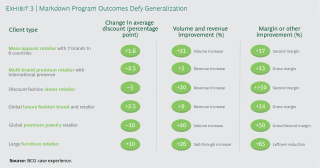For allpercentage increase (markup) and percent off (discount) calculations, there are five potential variables. You may not always care about them, and in fact, you may not even be aware of them, but they are nonetheless there. Don't let this be off-putting. The user needs only provide values for two of the five, and the calculator will calculate the other three. More below
A markdown of 40% decreases the price of the shirt by $30. 0.4 = $12. So the final cost of the shirt is $30 - $12 = $18. Shalon is happy with this price, so she starts to pass out 40% off coupons. The term discount can be used to refer to many forms of reduction in price of a good or service. Two types of discounts are discounts in which you get a percent off, or a fixed amount off. A percent off of a price typically refers to getting some percent, say 10%, off of the original price of the product or service. For example, if a good costs.
Note: Whether you explicitly enter a markup or a discount percentage, the calculator always calculates the other. A user can't provide both. The results need to be kept in sync. A 10% increase is always 9.0909...% off. That fact never changes.
To calculate a particular percentage increase, the user enters these two values:
How to calculate percentage markup and percentage discounts.
- Enter 'Net Amount.'
- Enter 'Percent Increase (markup).'
- Set the other three inputs to 0.
To figure out what percentage an increase is, the user has these options
- Enter 0 for 'Percent Increase (markup).'
- Enter the 'Net Amount.'
- And enter either 'Amount Added/Subtracted' or 'Gross Amount.'
- Set the other inputs to 0.
Percentage Off Calculator
To calculate a particular percent off, the user enters these two values:

- Enter 'Gross Amount.'
- Enter 'Percent Off (discount).'
- Set the other three inputs to 0
To figure out what percent off a discount is, the user has these options
- Enter 0 for 'Percent Off (discount).'
- Enter the 'Gross Amount.'
- And enter either 'Amount Added/Subtracted' or 'Net Amount.'
- Set the other inputs to 0.
Loan Calculator
- Solve for multiple unknowns
- Create a good looking printable payment schedule
- Colorful charts help visualize a loan's cost
- Supports extra payments too!
Retirement Calculator
Are you on track?

- Considers pre and post retirement cash flows
- Allows for multiple income sources
- Factor in inflation - Yikes!
Rental Income Calculator
Calculate ROI (return-on-investment) before and after taxes.
- Creates a printable cash flow schedule.
- Considers taxes, depreciation, inflation and more.
- Allows for 1 or 2 mortgages.
Is a property a good investment?
The percent increase and percent off are percent change calculations. And they have been presented above in a traditional way. For a percentage increase start with a net amount and increase it by a given percent or amount to find the gross amount. We can say the same about the percentage off example. We started with a gross amount and deducted either an amount or a percentage.
These are traditional examples. But this calculator allows the user to provide what is normally the implied percentage in the traditional example and the calculator will calculate the percentage that the user usually provides.
What does this mean?
I'll tell you.
Take a percent increase calculation. Rather than provide a 'Net Amount' and 'Amount Added/Subtracted', the user can provide the 'Gross Amount' instead of the 'Net Amount' and the calculator will still calculate the 'Percent Increase (markup).'
What is the benefit of this?
Well, there are several uses for being able to calculate a percent change from the reverse of the traditional perspective.
If, for example, you are someone who purchases items for resale and you want to make a 30% markup, start by entering the 'Gross Amount,' say $49.95, and the 'Percent Increase (markup)' 30%. The calculator will calculate the price you have to purchase the product for to make your markup.
Related - Interested in a more thorough discussion covering percents, ratios, and fractions? Then see this Percentage Calculators page.
IRR Calculator
Calculate an annualized rate-of-return and more.
- Exact date investments and withdrawals
- Calculates net present value too.
- Know your rate of return across multiple accounts and investments
Answers the question, 'How am I doing?'
Ultimate Financial Calculator™
Time-value-of-money calculations with regular or irregular cash flows. Solve for:
- Present Value (PV)
- Future Value (FV)
- Payment amount, rate or term
- Annualized rate-of-return
- New - save data to file
Markup & Discount Calculator Help
In some businesses, accountants and other managers have to simultaneously work with both markups (cost or net amount plus a percentage) and discounts or mark-downs (a total or gross amount less a percentage). The five values you see can be either a user input or a calculated result. This calculator allows you to calculate three values by entering just two values.
Either Net Amount is the amount before adding the markup, or it is the amount after calculating the discount.
Markup percentage is the percentage added to the net amount. $100 plus a 5.0% markup results in a Gross Amount of $105.

The Amount is $5.00, that is the difference between the Net Amount and the Gross Amount.
The Discount Percent is the percentage deducted from the Gross Amount. $105 minus a 5.0% discount equals a Net Amount of $99.75. (The Amount is $5.25).
Either the 'Gross amount' is the amount before deducting the discount, or it is the amount after calculating the markup.
Example 1: You purchased 1,000 shares of stock for a total price of $23,554.00. Enter this in the 'Gross Amount'. You later sold the stock for a loss, and you received only $19,054.00. Enter this in the 'Net Amount.' Click [Calc]. The Discount Percentage is your percentage lost, i.e., 19.1%. The Markup Percentage is the percentage you have to earn on a trade to make up the loss, i.e., 23.6%. This calculation assumes you are will to reinvest the entire $19,054.
Example 2: Sales tax is a markup percentage. That is, we add sales tax to the net amount. If you want to sell or advertise an item at a price that includes sales tax, you cannot use the sales tax rate (percentage) to calculate a deduction from the sale price to know the net selling price. To calculate the net sale price, enter the total gross price, including the tax amount that you want to sell the item for in the Gross Amount - say $495.00. Enter the sales tax rate into the Markup Percentage, say 7%. Set the other three inputs (Net Amount, Amount, and Discount Percentage) to 0.0. Calculate.
The Net Amount, before sales tax is $462.62 and the Amount (the sale tax in this case) is $32.38
Discount Markdown Definition
Example 3: You can use the calculator to calculate the net purchase amount, assuming a known markup. If you can sell an item for $75 and you want to make a 30% markup, what price do you have to pay for the item? Enter $75.00 for 'gross amount' and 30% for the 'markup percent'. You have to buy at $57.69. The profit (or difference) is $17.31, and the markdown percent is 23.08%. You can use this to calculate the buy-to-cover price for a short position if you cover base on a profit goal.
